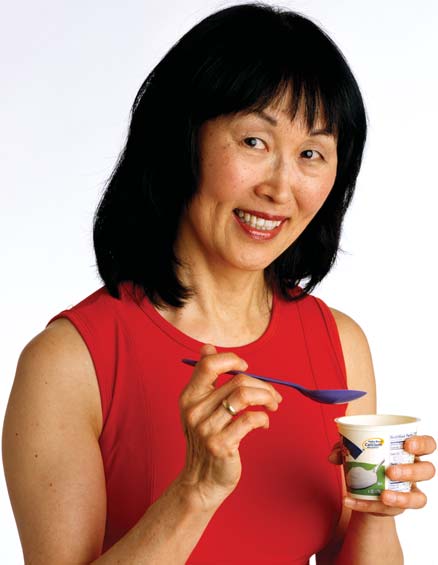● Use reduced-sodium or no-salt-added products. Examples are no-salt-added canned vegetables or ready-to-eat cereals that have no added salt or the lowest amount of sodium listed on the Nutrition Facts panel on the food label.
● When you cook, be “spicy” instead of “salty.” Flavor foods with herbs, spices, wine, lemon, lime, or vinegar. Be creative!
● Don’t bring the salt shaker to the table. Try an herb substitute instead, such as powdered garlic, onion, or thyme.
● Use fresh poultry, fish, and lean meat, rather than canned, smoked, or processed types.
● Cut down on cured foods (such as bacon and ham), foods
packed in brine (such as pickles and olives), and condiments (such as mustard, ketchup, barbeque sauce, and monosodium glutamate). You should even limit lower sodium versions of soy sauce and teriyaki sauce.
● Read the Nutrition Facts label on the food package and choose convenience foods that are lower in sodium. These foods
include frozen dinners, pizza, breads, packaged mixes, canned soups and broths, and salad dressings.
● Rinse canned foods, such as tuna and canned beans, to
remove some of the sodium.
While salt substitutes containing potassium chloride may be useful for some individuals, they can be harmful to people with certain medical conditions. Ask your doctor before trying salt substitutes.
our Guide to a Healthy Heart
Don’t Pass the Salt
Y
53
What Else Affects Blood Pressure?
A number of foods and other factors have been reported to affect blood pressure. Here are the latest research findings:
Garlic and onions. These foods have not been found to affect blood pressure. But they are tasty, nutritious substitutes for salty season-ings and can be used often.
Caffeine. This may cause blood pressure to rise, but only temporarily.
Unless you are sensitive to caffeine, you do not have to limit how much you consume in order to prevent or control high blood pressure.
Stress. Stress, too, can make blood pressure go up for a while, and is popularly thought to contribute to high blood pressure. But the long-term effects of stress are not clear. Furthermore, stress management techniques alone do not seem to prevent high blood pressure.
However, stress management approaches may help you control other unhealthy habits, such as overeating or smoking.
High Blood Cholesterol and the TLC Program
TLC is a treatment program that stands for “Therapeutic Lifestyle Changes.” This program helps reduce LDL cholesterol via a low-saturated fat, low- trans fat, low-cholesterol eating plan. The program also emphasizes regular physical activity and weight control. Adopt the TLC approach and you’ll lower your chances of developing heart disease, future heart attacks, and other heart disease complications. (The main difference between the TLC and the DASH eating plans is that the TLC plan puts more emphasis on decreasing saturated fat and trans fat to lower blood cholesterol levels.) Taking Charge: An Action Plan for Heart Health
Now You’re Cooking: Limiting Saturated Fat, Trans Fat, and Cholesterol Planning and preparing nutritious meals may take a little extra effort, but the health benefits are huge. Here are some tips for cutting down on saturated fat, trans fat, and dietary cholesterol, which will help lower your LDL cholesterol and reduce your heart disease risk. It will improve heart health for everyone, and may be particularly helpful to those following the TLC eating plan.
Meat, Poultry, and Fish
■ Choose fish, poultry, and lean cuts of meat. Trim the fat from meats; remove the skin and fat from chicken. Keep portion sizes moderate.
54
Mineral Medicine:
Another Way To Control Blood
Pressure
Certain mineral-rich foods can help keep blood pressure levels healthy. For example, a diet rich in potassium can help to both prevent and control high blood pressure. A potassium-rich diet not only blunts the effects of salt on blood pressure, but may also reduce the risk of developing kidney stones, and possibly decrease bone loss with age. But be sure to get your potassium from food sources, not from supplements. Many fruits and vegetables, some dairy foods, and fish are rich sources of potassium.
Calcium and magnesium are two other minerals that may help to prevent high blood pressure, as well as improve health in other ways. Low-fat or fat-free milk and milk products are rich sources of calcium, while magnesium is found in many whole-grain
products; dark green, leafy vegetables; fish; and dry beans.
Mineral Medicine
■ Broil, bake, roast, or poach instead of frying. When you do fry, use a nonstick pan and a nonstick cooking spray or a very small amount of oil or margarine.
■ Cut down on sausage, bacon, and processed, high-fat cold cuts (which are also high in sodium).
Milk Products and Eggs
■ Instead of whole milk or cream, use fat-free or 1-percent milk.
■ Use fat-free or low-fat cheeses and yogurt.
■ Replace ice cream with sorbet, sherbet, and fat-free or low-fat frozen yogurt. Keep portion sizes moderate.
■ Limit the number of egg yolks you eat. Egg whites contain no fat or cholesterol, so you can eat them often. In most recipes, you can substitute two egg whites for one whole egg.
■ Use soft margarines (liquid or tub types) that contain little or no trans fat. Some brands of soft margarines are high in plant our Guide to a Healthy Heart
sterols or stanols, which lower LDL cholesterol.
Y
55
Give Your Heart a Little TLC
If your LDL cholesterol is above your goal level (see page 22), you should start on the TLC eating plan right away. Consuming foods that are high in saturated fat, trans fat, and cholesterol contributes to high levels of LDL cholesterol. On the TLC eating plan, you should consume:
● Less than 7 percent of the day’s total calories from saturated fat.
Lowering saturated fat is the most important dietary change for reducing blood cholesterol.
● Less than 200 milligrams of dietary cholesterol per day.
● Just enough calories to achieve or maintain a healthy weight.
If your blood cholesterol is not lowered enough on the TLC
eating plan, your doctor or registered dietitian may advise you to increase the amount of soluble fiber and/or add cholesterol-lowering food products to your diet. These products include margarines that contain “plant sterols” or “plant stanol esters,”
which are ingredients that lower LDL cholesterol. If your LDL
level is still not lowered enough, your doctor may prescribe a cholesterol-lowering drug along with the TLC eating plan. For more information, see NHLBI’s Web page, “Live Healthier, Live Longer.” (See “To Learn More” on page 88.)
TLC Taking Charge: An Action Plan for Heart Health
Grains and Grain Products
■ Eat foods with lots of fiber and nutrients and make sure that half of your grain products are whole grain. These include whole-grain breads, pasta, and cereals, as well as brown rice.
When you check package labels, look for the word “whole” in the ingredients. Make sure that whole grains appear among the first items listed.
Sauces, Soups, and Casseroles
■ After making sauces or soups, cool them in the refrigerator and skim the fat from the top. Do the same with canned soups.
56
■ Thicken a low-fat sauce with cornstarch or flour.
■ Make main dishes with whole-grain pasta, brown rice, or dry peas and beans. If you add meat, use small pieces for flavoring rather than as the main ingredient.
When You Can’t Face Cooking
Check the Nutrition Facts label on food packages to choose frozen dinners and pizzas that are lowest in saturated fat, trans fat, and cholesterol. Also watch the calories and sodium content. Make sure the dinners include vegetables, fruits, and whole grains—or add them on the side.
Choose store-bought baked goods that are lowest in saturated fat, cholesterol, trans fats, and hydrogenated (hardened) fats. Also, remember that even “no cholesterol” and fat-free baked goods still may be high in calories.
Dining Out for Health
With a little planning and a willingness to speak up you can eat healthfully when you dine out. Here are some tips.
Ask for what you want. Most restaurants will honor your requests.
You have nothing to lose by asking!
Order small. To reduce portion size, try ordering appetizers or children’s portions as your main meal. Or, take half of your entrée home with you for lunch the next day.
Ask questions. Don’t hesitate to ask your server how foods are prepared and whether the restaurant will make substitutions.
Ask if they will:
■ Serve low-fat or fat-free milk rather than whole milk or cream.
■ Tell you the type of cooking oil used. (Preferred types that are lower in saturated fat are canola, safflower, sunflower, corn, and olive oils.)
■ Trim the fat off poultry or meat.
■ Leave all butter, gravy, and sauces off an entrée or side dish.
■ Add no salt during cooking.
■ Serve salad dressing on the side.
■ Meet special requests if you make them in advance.
our Guide to a Healthy HeartY

57
Select foods cooked by low-fat methods. Look for terms such as broiled, baked, roasted, poached, or lightly sautéed.
Limit foods high in calories and fats, especially saturated fat and
trans fat. Watch out for terms such as fried, crispy, creamed, escal-loped, hollandaise, bernaise, casserole, and pastry crust.
Make Healthy Choices
■ Breakfast: Fresh fruit, small glass of citrus juice, low-fat or fat-free milk and yogurt, whole-grain bread products and cereals, omelet made with egg whites or egg substitute.
■ Beverages: Water with lemon, flavored sparkling water, juice spritzer (half fruit juice and half sparkling water), iced tea, reduced-sodium tomato juice.
■ Breads: Most yeast breads are low in calories and fat—as long as you limit the butter, margarine, or olive oil. Choose whole-grain breads, which are packed with important nutrients and are full of fiber to make you feel fuller faster. Also, watch the sodium content.
■ Appetizers: Steamed seafood, fresh fruit, bean soups, salad with reduced-fat dressing.
■ Entrées: Skinless poultry, fish, shellfish, vegetable dishes, or pasta with red sauce or vegetables. Limit your use of butter, margarine, and salt at the table.
■ Salads: Fresh lettuce, spinach, and other
greens; other fresh vegetables, chickpeas,
and kidney beans. Skip high-fat and
Taking Charge: An Action Plan for Heart Health
high-calorie nonvegetable choices
such as deli meats, bacon, egg,
cheese, and croutons. Choose
lower-calorie, reduced-fat, or
fat-free dressings, lemon
juice, or vinegar.
■ Side Dishes: Vegetables and grain
products, including whole-grain
rice or noodles. Ask for
salsa or low-fat yogurt
instead of sour cream
or butter.

58
■ Dessert: Fresh fruit; fat-free frozen yogurt, sherbet, or fruit sorbet (usually fat free, but ask for the calorie content). Try sharing a dessert. If you drink coffee or tea with dessert, ask for low-fat or fat-free milk instead of cream or half-and-half.
Know your foods. Following are some additional tips on shopping, cooking, and eating for heart health:
■ To choose foods wisely, see “How To Use the Nutrition Facts Label on the Food Package” on page 47 and “The Lowdown
on Labels.”
■ To prepare and eat heart healthy meals, see “Figuring Out Fat”
on page 60.
■ For other tips on making good food choices, see “How To Tame a Snack Attack” below and “Vitamins for Heart Health” on page 62.
How To Tame a Snack Attack
Many snacks, including many types of cookies, crackers, and chips, are high in saturated fat, trans fat, cholesterol, sodium, and calories.
But that doesn’t mean you have to cut out all between-meal treats.
Keep the foods listed below on hand for snack attacks. But, keep in mind that while these foods may be low in fat, many are not low in calories. So watch how much you eat, especially if you are trying to control your weight.
Here are some healthier, low-fat snacks:
■ 100-percent fruit juices
■ Low-fat or fat-free milk
■ Fat-free frozen yogurt,
sherbet, and sorbet
■ Low-fat cookies such as
animal crackers, graham
crackers, ginger snaps, and
fig bars
■ Low-fat crackers such
as melba toast, or rice,
rye, and soda crackers;
look for unsalted or
low-sodium types
our Guide to a Healthy HeartY
59
The Lowdown on Labels
Food labels can help you choose items that are lower in sodium, saturated and total fat, trans fat, cholesterol, and calories. When you grocery shop, look for these claims on cans and other packag-ing—and use this guide to find out what each claim really means.
Sodium Claims
What They Mean
Sodium free or salt free
Less than 5 mg of sodium per
serving
Very low sodium
35 mg or less per serving
Low sodium
140 mg or less per serving
Low sodium meal
140 mg or less per 31/2 ounces
Reduced or less sodium
At least 25 percent less per serv-
ing than the regular version
Unsalted or no salt added
No salt added during processing
Fat Claims
What They Mean
Fat free
Less than 1/2 gram of fat per
serving
Low saturated fat
1 gram or less of saturated fat
per serving
Reduced fat
At least 25 percent less fat per
serving than the regular version
Light
50 percent less fat than the
regular version
Calorie Claims
What They Mean
Taking Charge: An Action Plan for Heart Health
Calorie free
Less than 5 calories per serving
Low calorie
40 calories or less per serving
Reduced or less calories
At least 25 percent fewer calories
per serving than the regular version
Light or “lite”
Half the fat or one-third of the
calories per serving of the
regular version
Lowdown on Labels

60
Figuring Out Fat
Your personal fat allowance depends on how many calories you consume each day. If you do not have high blood cholesterol or heart disease, the saturated fat in your diet should be less than 10 percent of your daily calories, and total fat should be 20–35
percent of calories. Most fats should come from foods that are high in polyunsaturated fats and monosaturated fats, such as fish, nuts, and vegetable oils.
The table below shows the maximum amount of saturated fat you should eat, depending on how many calories you take in each day. If you have high blood cholesterol or heart disease, the amount of saturated fat will be different. (See “Give Your Heart a Little TLC,” on page 55.) Check the Nutrition Facts label on food packages to find out the number of fat grams—
both saturated and total—in each serving.
Total Calorie Intake
Limit on Saturated Fat Intake
1,600
18 g or less
2,000*
20 g or less
2,200
24 g or less
2,500*
25 g or less
2,800
31 g or less
* Percent daily values on the Nutrition Facts label on the food package are based on a 2,000-calorie diet.
Values for 2,000 and 2,500 calories are rounded to the nearest 5 grams to be consistent with the Nutrition Facts label.
Figuring Out Fat
our Guide to a Healthy HeartY
61
■ Fresh or dried fruit, or fruits canned in their own juice
■ Vegetable sticks; try a dab of reduced-fat peanut butter on celery sticks
■ Air-popped popcorn with no salt or butter; fat-free, low-sodium pretzels
Aim for a Healthy Weight
If you are overweight or obese, taking pounds off can reduce your chances of developing heart disease in several ways. First, losing weight will directly lower your risk. Second, weight loss can help to reduce a number of other risk factors for heart disease, as well as lower your risk for other serious conditions. Weight loss can help control diabetes, as well as reduce high blood pressure and high blood cholesterol. Reaching a healthy weight can also help you to sleep more soundly, experience less pain from arthritis, and have more energy to take part in activities you enjoy.
Remember, if you need to lose weight, even a small weight loss will help lower your risk for heart disease and other serious health conditions. At the very least, you should not gain any additional weight.
A recent study found that young adults who maintain their weight over time, even if they are overweight, have lower risk factors for heart disease in middle age than those whose weight increases.
When it comes to weight loss, there are no quick fixes. Successful, lasting weight loss requires a change of lifestyle, not a brief effort to drop pounds quickly. Otherwise, you will probably regain the weight. Aim to lose between 1/2 pound to 2 pounds per week—
no more. If you have a lot of weight to lose, ask your doctor, a registered dietitian, or a qualified nutritionist to help you develop Taking Charge: An Action Plan for Heart Health
a sensible plan for gradual weight loss.
To take off pounds and keep them off, you will need to make changes in both your eating and physical activity habits. Weight control is a question of balance. You take in calories from the foods you eat. You burn off calories during physical activity.
Cutting down on calories, especially calories from fat, is key to losing weight. Combining this change in diet with a regular physical activity program, such as walking or swimming, will help you both shed pounds and stay trim for the long term.

62
Vitamins for Heart Health:
Choose Foods,
Not Supplements
Until recently, it was believed that antioxidant vitamins, particularly vitamin E and beta carotene, might protect against heart disease and stroke, as well as cancer. But new research shows that taking these vitamins in supplement form can be harmful—
even deadly.
In the case of vitamin E supplements, a review of 19 studies showed that daily doses of 400 IUs or more may significantly increase the risk of death from all causes. Meanwhile, two major studies showed that supplementation with beta carotene (a substance that is converted to vitamin A in the liver) increases the risks of lung cancer and death in smokers. Other recent studies have shown that there are no benefits to taking either vitamin E or beta carotene supplements to prevent cardiovascular diseases or cancer.
But studies suggest that antioxidants in foods do protect heart health. So keep eating plenty of foods that are packed with these vitamins. Foods rich in vitamin E include vegetable oils (especially safflower and sunflower oils), wheat germ, leafy green vegetables, and nuts (almonds and mixed nuts).
Foods rich in beta carotene are
carrots, yams, peaches, pumpkin,
apricots, spinach, and broccoli.
Note: If you are taking vitamin E
supplements for protection against
medical conditions other than
cardiovascular diseases or
cancer, talk with your doctor
about the risks and benefits
of higher dose vitamin E
supplements.
our Guide to a Healthy HeartY
63
Getting Started
Anyone who has ever tried to lose weight—and keep it off—knows that it can be quite a challenge. Here are some tips to help you succeed: Eat for health. Choose a wide variety of low-calorie, nutritious foods in moderate amounts. Include vegetables, fruits, whole grains, and low-fat or fat-free milk, as well as fish, lean meat, poultry, or dry beans. Choose foods that are low in fat and added sugars. Choose sensible portion sizes. (See “Portion Distortion” on page 68.) Watch calories. To lose weight, most overweight people will need to cut 500 to 1,000 calories per day from their current diet.
For tips on choosing low-fat, low-calorie foods, see “The Substitution Solution” on pages 66–67.
Keep milk on the menu. Don’t cut out milk products as you try to reduce calories and fat. Milk and milk products are rich in calcium, a nutrient that helps prevent the bone-thinning disease osteoporosis.
Instead, choose low-fat or fat-free milk and milk products, which have the same amount of calcium as whole-milk products. Make the switch gradually. If you are used to drinking whole milk, first cut back to 2 percent, then move to 1 percent, and finally to fat-free milk.
Keep moving. Physical activity is key to successful, long-term weight loss. It can help you burn calories, trim extra fat from your waist, and control your appetite. It can also tone your muscles and increase aerobic fitness. To lose weight and to prevent further weight gain, gradually build up to at least 60 minutes of moderate-intensity physical activity on most, and preferably all, days of the Taking Charge: An Action Plan for Heart Health
week. If you’ve lost weight, in order to keep it off, you’ll need to do even more physical activity—from 60–90 minutes of daily moderate-intensity physical activity. But you don’t need to run yourself ragged. A recent study showed that moderate physical activity, such as brisk walking, helps people lose weight as effectively as more vigorous exercise. For more tips, see “Get Moving!” on page 72.
Steer clear of fast food. A single meal from a fast food restaurant may contain as many calories as you need for a whole day! A recent study showed that young adults who eat frequently at fast food restaurants gain more weight and are at higher risk for diabetes in middle age than those who avoid the fast food habit. If you do eat 64
at a fast food restaurant, choose salads and grilled foods, and keep portion sizes small. Ask for salad dressings, mayonnaise, and other high-fat condiments to be served on the side—or not at all.
Know about medicines. If you are very overweight, or if you are overweight and have other weight-related risk factors or diseases, your doctor may advise you to take a medicine to help you take off pounds. You should use a weight-loss drug only after you have tried a low-calorie diet, more moderate-intensity physical activity, and other lifestyle changes for 6 months without successfully losing weight. Because weight-loss medicines have side effects, you should consider all of the risks and benefits before trying one of them.
These drugs should be used along with a low-calorie eating plan and regular physical activity, not as a substitute for these lifestyle changes.
Get support. Tell your family and friends about your weight-loss plans and let them know how they can be most helpful to you.
Some people also find it useful to join a structured weight-loss program. The most effective groups provide support and advice for permanently changing eating and physical activity habits. (See “How To Choose a Weight-Loss Program” on page 70.)
Lock in your losses. After reaching your weight-loss goal, switch your efforts to keeping the weight off by continuing to eat a nutritious, lower calorie diet and getting regular physical activity. To maintain your weight, you’ll need to become even more active than before: Aim for 60 to 90 minutes of physical activity per day.
While this may seem like a tall order, remember that you can count the activities that you’re already doing. Common daily activities such as climbing stairs, pushing a stroller, unloading groceries, gardening, and brisk walking all count as physical activity. Just be sure you do enough of them!
Seven Secrets of Weight Management
If you have ever tried to take off weight, you know that it’s more than a matter of promising yourself that you’ll eat less and move more.
You also need to mentally prepare yourself for new behaviors. Here are some tips for getting and staying in a healthy weight mindset.
Start small. Many people set unrealistic goals for the amount of weight they want to lose. But you can greatly improve your health our Guide to a Healthy Heart
by losing just 5 to 10 percent of your starting weight. While you Y
65
may choose to lose more weight later, keep in mind that this initial goal is both realistic and valuable.
Set smart goals. It’s important to set goals that are specific, achievable, and “forgiving” (allow you to be less than perfect). For example, “exercise more” is a fine goal, but it’s not very specific.
“Walk for 60 minutes e







